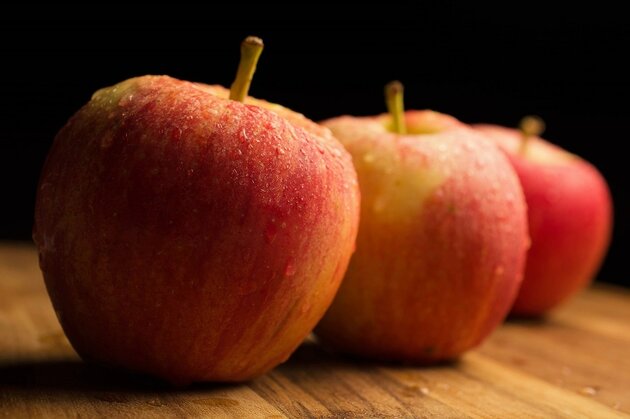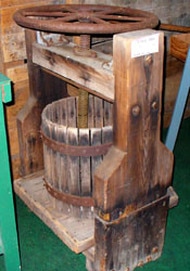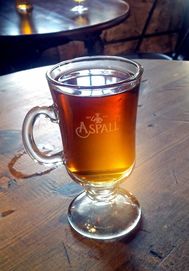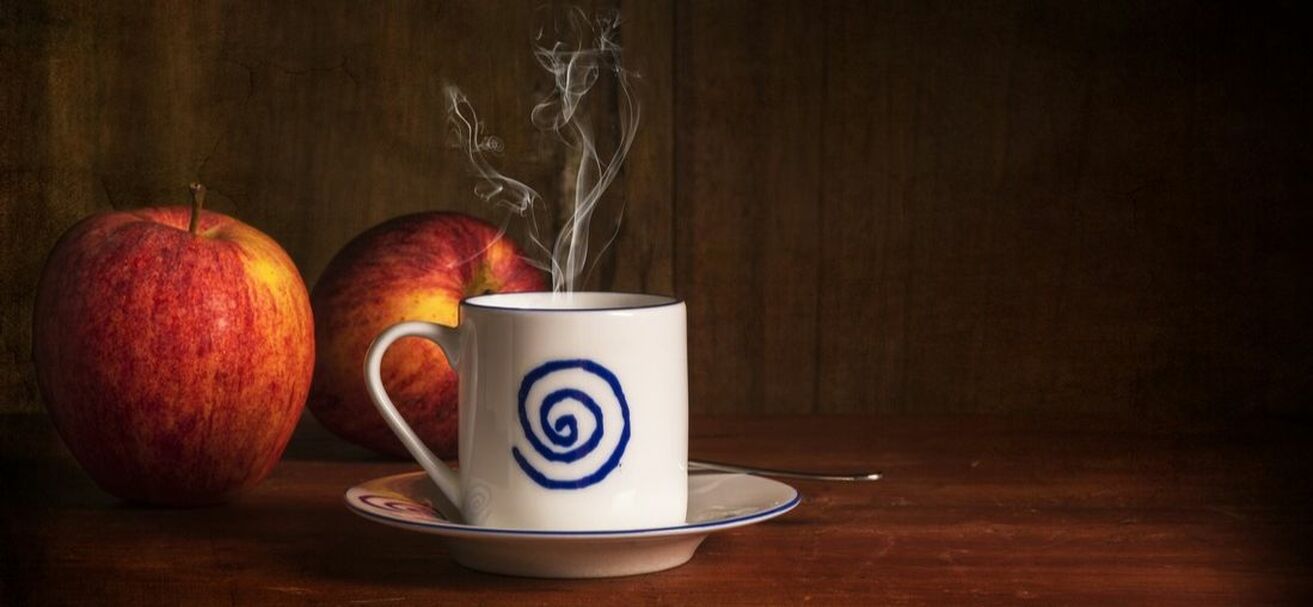Apple Cider Vinegar
|
A.C.V.
|
The History of Apple Cider Apple cider began not has a health food but as a strong alcoholic beverage. The earliest record of apple cider was documented by the Romans when they arrived in England around 55 BC. They reported that the locals were consuming a delicious cider beverage made from apples. Shortly thereafter Julius Caesar pursued this alcoholic beverage and it became common throughout the Roman Empire.
How long the villagers in England had been producing and consuming apple cider is unknown. However, historians agree that the area of the Nile River Delta, in Egypt, had been an early producer of apple trees dating as far back as 1,300 BC. So it can be assumed that the beverage is quite old (1). |
By 1066, or the beginning of the ninth century, orchards could be found throughout England and Europe dedicated to producing cider apples. Monasteries are known to have sold large quantities of spiced apple cider to their communities, and laborers are known to have received alcoholic apple cider as a form of payment for their work. Alcoholic apple cider was widely popular during the medieval period.
In regards to apple cider in America, the tradition of consuming this alcohol beverage was readily accepted because of a number of factors. To begin, the settlers that arrived in America during the colonial period brought with them a variety of grains. These grains did not grow well on American soil and were also quite expensive to import. At this same time, apple orchards were thriving. The result was an abundance of cheap, delicious apples. This abundance was due, in part, to the well-known efforts of the American legend, Johnny Appleseed.
The popularity of the alcoholic beverage eventually declined because of the establishment of breweries by German immigrants, with the Prohibition sending the practice to its grave (1).
For an in-depth history on apple cider in America, please visit the Nation Apple Museum's website.
In regards to apple cider in America, the tradition of consuming this alcohol beverage was readily accepted because of a number of factors. To begin, the settlers that arrived in America during the colonial period brought with them a variety of grains. These grains did not grow well on American soil and were also quite expensive to import. At this same time, apple orchards were thriving. The result was an abundance of cheap, delicious apples. This abundance was due, in part, to the well-known efforts of the American legend, Johnny Appleseed.
The popularity of the alcoholic beverage eventually declined because of the establishment of breweries by German immigrants, with the Prohibition sending the practice to its grave (1).
For an in-depth history on apple cider in America, please visit the Nation Apple Museum's website.
The History of Vinegar Like many "ancient" products we have today, the creation of vinegar was an accident. It is said that vinegar was made by chance well over 10,000 years ago. The process is quite simple. Sugars are fermented into alcohol and then a secondary fermentation process turns the alcohol into vinegar.
Imagine: you're wandering along the Nile some 10,000 years ago and come across a heap of apples laying to rest under an old tree, turning in the sun. You try one batch and it's fizzy and strong, nearly making you dizzy from the smell and taste. You like it. So you go on to try another batch located at a nearby tree, but this one is even stronger - it's soured. The muscles in your face seize and go numb; you've just discovered apple cider and it's further fermented state of maturity, vinegar. The Babylonians were one of the first to record the use of vinegar, circa 5,000 BC. They are recorded using vinegar as not only a condiment to flavor their food but also as a preservative. You can imagine a Babylonian experiencing the same scenario described above (2). Hippocrates was one of the first to speak of its medicinal properties, and its healing characteristics are also referenced frequently throughout the bible. Today vinegar is as commonly found in the kitchens of households and five-star restaurants as it is in the arsenal of degreasers and disinfectants used to clean those very spaces. It is perhaps one of the most versatile products ever discovered by humans (2). |
What Is In Apple Cider Vinegar? Cider is to apples as vinegar is to cider. Apple cider vinegar is created after the apple cider experiences a secondary fermentation process.
During the secondary fermentation process, bacteria, yeast, and sometimes ash and other earth elements are added to the cider. The alcohol and remaining sugars are then converted into vinegar. This process can vary in length depending on ambient temperatures; two weeks in warm weather and up to two months in the cold (1). Antique Cider Press from the 1860s in the National Apple Museum |
How Apple Cider Vinegar Benefits Our Body
The benefits of apple cider vinegar are numerous. Read on to consider if adding A.C.V. to your daily routine interests you,
The Skin
Apple cider vinegar naturally does wonders for our skin. Here's why (3):
- A.C.V. is made with ashes, which gives A.C.V. the ability to normalize your pH, internally and externally. This allows our organs (your skin is an organ!) to maintain a balanced alkalinity.
- A.C.V. has an anti-microbial effect (viruses, bacteria, fungus) due to maleic acid - check out "Antifungal" below.
- A.C.V. has not only calcium and potassium but also vitamins A, B1, B6, C and E
- A.C.V is an exfoliant. This means it will remove dead skin cells.
Antifungal properties
A postgraduate program study in dentistry was conducted in João Pessoa, Paraíba, Brazil. The purpose of the study was to evaluate the antifungal activity of A.C.V. on Candida spp. accompanied by denture stomatitis (gum pain and inflammation that occurs when one has dentures) (4).
The study:
The study:
- A.C.V. contains maleic acid, which provides the vinegar with its antimicrobial properties.
- the A.C.V. was tested against nystatin (the controlled substance) which is known for its antifungal properties.
- Different concentrations of the substances were tested and studied.
"Apple cider vinegar (4%) showed MIC of 2500 μg/ml and MFC of 2500, 5000, and 10,000 μg/ml depending on the strain tested. Nystatin showed MIC of 3.125 μg/ml and strain-dependent MFC values ranging from 3.125 to 12.5 μg/ml. The microbial kinetic assay showed a statistical difference between apple cider vinegar and nystatin (p < 0.0001). After 30 minutes of exposure, apple cider vinegar showed fungicidal effect at MICx4, whereas nystatin maintained its fungistatic effect. " - pubmed.gov
Conclusion:
A.C.V. exhibited antifungal properties against the Candida spp. which means that it can be safely used as an alternative medicine to treat denture stomatitis. One may also be able to use apple cider vinegar as a cure for other anti-microbial problems with little to no side effects (4).
A.C.V. exhibited antifungal properties against the Candida spp. which means that it can be safely used as an alternative medicine to treat denture stomatitis. One may also be able to use apple cider vinegar as a cure for other anti-microbial problems with little to no side effects (4).
Research On Cholesterol
In a study by the Department of Biophysics performed by the Medical Faculty at Demirel University in Isparta, Turkey, they found the A.C.V. can be used to regulate oxidative stress on kidney and liver membranes.
- The study was conducted on mice fed who were fed a high cholesterol diet.
"The purpose of this study was to investigate the potentially beneficial effects of apple cider vinegar (ACV) supplementation on serum triglycerides, total cholesterol, liver and kidney membrane lipid peroxidation, and antioxidant levels in ovariectomized (OVX) mice fed high cholesterol." - Suleyman Demirel University (6)
Conclusion:
A.C.V. had a protective effect against oxidative injury for the liver and kidney's, and in addition lowered the serum lipid levels. Note, this study was conducted on mice who were fed high cholesterol diets (6).
This means that for people who have a high cholesterol diet, a supplement of apple cider vinegar with every meal may help control cholesterol levels and reduce the stress that is induced in the liver and kidneys.
A.C.V. had a protective effect against oxidative injury for the liver and kidney's, and in addition lowered the serum lipid levels. Note, this study was conducted on mice who were fed high cholesterol diets (6).
This means that for people who have a high cholesterol diet, a supplement of apple cider vinegar with every meal may help control cholesterol levels and reduce the stress that is induced in the liver and kidneys.
In Weight Loss
What do North-African cultures and bodybuilders have in common? They have both been found to use apple cider vinegar drinks to induce weight loss (5).
So why do people claim that apple cider vinegar promotes weight loss? It's a simple concept if we think about it in the terms of dietary fiber and protein.
Fiber and protein promote satiation, that is, the feeling of being "full" after one has a meal. That's why protein bars are packed full of protein and fiber. Fruits and vegetables are also loaded with fiber, in this case, we will refer to apples.
Apple cider vinegar contains the same amount of pectin as apples. This makes sense because the vinegar is, after all, made from apples! So what's so special about pectin? Let's have a look at a study conducted by the Obesity & Metabolic Health Division of the Rowett Institute of Nutrition & Health at the University of Aberdeen in Scotland.
In this experiment, adult obese rats that were raised on high-fat diets were fed supplemental protein and pectin:
So why do people claim that apple cider vinegar promotes weight loss? It's a simple concept if we think about it in the terms of dietary fiber and protein.
Fiber and protein promote satiation, that is, the feeling of being "full" after one has a meal. That's why protein bars are packed full of protein and fiber. Fruits and vegetables are also loaded with fiber, in this case, we will refer to apples.
Apple cider vinegar contains the same amount of pectin as apples. This makes sense because the vinegar is, after all, made from apples! So what's so special about pectin? Let's have a look at a study conducted by the Obesity & Metabolic Health Division of the Rowett Institute of Nutrition & Health at the University of Aberdeen in Scotland.
In this experiment, adult obese rats that were raised on high-fat diets were fed supplemental protein and pectin:
"Adult diet-induced obese rats reared on high-fat diet (45% energy from fat) were given experimental diets ad libitum for 4 weeks (n = 8/group): high fat control, high fat with high protein (40% energy) as casein or pea protein, or these diets with added 10% w/w pectin." - Obesity & Metabolic Health Division (8)
The study found that the obese rats fed dietary pectin and not high protein decreased food intake by 23% and in addition induced 23% body fat loss.
At the end of the study, the pectin-induced satiation led to a 12% decrease in body weight and a 44% reduction in body fat mass.
The researchers also found that the "plasma concentrations of satiety hormones PYY and total GLP-1 were increased by dietary pectin (168% and 151%, respectively) but not by high protein". (8)
Conclusion:
Drinking apple cider vinegar before or during a meal will help induce satiation from the food we eat, resulting in less food ingested and, eventually, a decrease in overall body fat.
We do not recommend you drink A.C.V in excess. Recipe recommendations below.
At the end of the study, the pectin-induced satiation led to a 12% decrease in body weight and a 44% reduction in body fat mass.
The researchers also found that the "plasma concentrations of satiety hormones PYY and total GLP-1 were increased by dietary pectin (168% and 151%, respectively) but not by high protein". (8)
Conclusion:
Drinking apple cider vinegar before or during a meal will help induce satiation from the food we eat, resulting in less food ingested and, eventually, a decrease in overall body fat.
We do not recommend you drink A.C.V in excess. Recipe recommendations below.
Obesity Research
This study was a collaborative by the Laboratory of Physiology of Nutrition at the Department of Biology at the University d'Oran in Ahmed Ben Bella, Oran, Algérie.
The purpose of this study was driven by a search for new, plant-based, anti-obesogenic treatments. There is a challenge in using plant-based medicine because of the possibility of side effects.
In this study, Wistar rats were given a high fat diet and also fed supplements of apple cider vinegar:
The purpose of this study was driven by a search for new, plant-based, anti-obesogenic treatments. There is a challenge in using plant-based medicine because of the possibility of side effects.
In this study, Wistar rats were given a high fat diet and also fed supplements of apple cider vinegar:
"Eighteen male Wistar rats (140±5g) were divided into 3 three equal groups. A witness group submitted to standard laboratory diet and two groups subjected to a high fat diet (cafeteria diet); one receives a daily gavage of apple cider vinegar (7mL/kg/d) for 30 days. Throughout the experiment monitoring the nutritional assessment, anthropometric and biochemical parameters is achieved." - University d'Oran (7)
Conclusion:
The study showed that the "metabolic disorders caused by high-fat diet (cafeteria) are thwarted by taking apple cider vinegar which proves to have a satiating effect, antihyperlipidemic and hypoglycemic effects, and seems to prevent the atherogenic risk" ( 7 ).
In short, a supplement of A.C.V. may help to reduce the effects that come with consuming high-fat diets.
The study showed that the "metabolic disorders caused by high-fat diet (cafeteria) are thwarted by taking apple cider vinegar which proves to have a satiating effect, antihyperlipidemic and hypoglycemic effects, and seems to prevent the atherogenic risk" ( 7 ).
In short, a supplement of A.C.V. may help to reduce the effects that come with consuming high-fat diets.
Apple Cider Vinegar Uses and Recipes
I drink a lot of apple cider vinegar. I buy gallons of it for business, and (as some of you may have noticed) I use it in every recipe found on this website. Not only is it a great preservative for our bath and body products, but it also has numerous health benefits. And, I've grown to love the taste.
Below you will find a short list of the ways in which I drink or cook with the product. Note, the taste is like that of wine or beer: acquired. Eventually, you get used to it, and maybe you will even grow to love it.
I prefer the brand Bragg's Apple Cider Vinegar, however there are several good alternatives. Most importantly, make sure the A.C.V. you choose is unfiltered and contains "the mother".
Below you will find a short list of the ways in which I drink or cook with the product. Note, the taste is like that of wine or beer: acquired. Eventually, you get used to it, and maybe you will even grow to love it.
I prefer the brand Bragg's Apple Cider Vinegar, however there are several good alternatives. Most importantly, make sure the A.C.V. you choose is unfiltered and contains "the mother".
Apple Cider Vinegar Drink Recipes:
A.C.V. Tea - Perfect On A Cold Day
Ingredients:
A.C.V. Orange Juice - Perfect At Breakfast
Ingredients:
Ingredients:
- 2 TBLS (try 1 to start) A.C.V.
- 2 tsp honey
- 1 tsp lemon juice
- 1 mug (cup or glass)
- 4-6 ounces of water
- heating element and pot/tea pot to boil water
- Heat water to a hot/boiling temperature, as you would for a cup of tea.
- Combined all ingredients in your desired mug (I'm a big-mug kinda guy).
- Pour hot water into the mug, stir, and enjoy!
A.C.V. Orange Juice - Perfect At Breakfast
Ingredients:
- 2 TBLS (try 1 to start) A.C.V.
- 4-6 ounces orange juice (not from concentrate!)
- 1 glass, cup, or mug
- Combined the A.C.V. and orange juice ingredients in your desired glass.
- Stir and enjoy!
Apple Cider Vinegar Food Recipes:
A.C.V. On Fries and Potatoes
What do ketchup, mustard, and mayonnaise all have in common? They are all made with vinegar!
I know this sounds weird, but you have to try it first! Have you ever had malt vinegar on french fries? Apple cider vinegar can be used on your food in the same way. Check out my recipe below:
Blake's Fried Potato Hash:
Estimated time: 30-35 minutes
Serves 1-2 people
Ingredients:
Directions:
What do ketchup, mustard, and mayonnaise all have in common? They are all made with vinegar!
I know this sounds weird, but you have to try it first! Have you ever had malt vinegar on french fries? Apple cider vinegar can be used on your food in the same way. Check out my recipe below:
Blake's Fried Potato Hash:
Estimated time: 30-35 minutes
Serves 1-2 people
Ingredients:
- 2 russet potatoes (or any potato, really)
- 1 large carrot, unpeeled
- 2 TBLS red onion
- 4 TBLS virgin unrefined or fractionated coconut oil
- Optional - 1/2 cup zucchini (around one-half of a zucchini)
- 1 tsp paprika (I prefer smoked)
- 1 tsp oregano
- salt and pepper to taste
- 2-3 TBLS Apple Cider Vinegar
- 1 cast-iron skillet with a lid (any pan will do, just be sure to have a lid or a top for it)
- heating element, gas, or electric burner.
Directions:
- Place your 4 TBLS of coconut oil into your pan
- Heat up your pan to medium/medium-low depending on the pan and heating element
- While the pan warms up, prepare your potatoes and carrots: I prefer to chop my carrots and potatoes into a square or rectangular shape.
- Once your potatoes are ready, you want to add them to the pan first- carrots will come later.
- Add potatoes and cover with a lid. Stir every 4-5 minutes.
- Cook potatoes for about 10 minutes with the lid on.
- Remove the lid from the pan and add your carrots. Cook for 10 minutes. Stir every 4-5 minutes.
- We will keep the lid off of the pan for the remainder of this recipe. When we initially cook with the lid on, we trap all the moisture in the potatoes and, essentially, steam the potatoes. This speeds up the cooking process of the potatoes and reduces the chance your potatoes will burn.
- Dice or loosely chop your red onion (I prefer diced)
- If you are using zucchini, I chop mine into quarter sized pieces, similar to the shape and size of my potatoes.
- After the carrots have been cooking for 10 minutes with the potatoes, you are now ready to add your red onion, paprika, oregano, and option zucchini.
- Cook for another ten to fifteen minutes, agitating the dish often, every 3 minutes or so.
- Once you feel your hash has dried out from the water and crisped up nicely (I prefer when the potatoes are a golden brown, not burnt), remove from the heat and portion onto a dish.
- Sprinkle with apple cider vinegar, salt and pepper to taste, and enjoy!
Works Cited:
1) Apple Cider, Apple Butter, Perry, and Vinegar. http://www.nationalapplemuseum.com/appleciderandmore.html
2) Vinegar Lore. http://versatilevinegar.org/vinegar-lore/
3) 5 reasons to wash your face (& skin) with apple cider vinegar. http://www.naturallivingideas.com/5-reasons-to-wash-your-face-with-apple-cider-vinegar/
4) Anti-fungal activity of apple cider vinegar on candida species involved in denture stomatitis. https://www.ncbi.nlm.nih.gov/pubmed/25219289
5) Unhealthy Weight loss. Erosion by apple cider vinegar. https://www.ncbi.nlm.nih.gov/pubmed/23373303
6) Apple cider vinegar modulates serum lipid profile, erythrocyte, kidney, and liver membrane oxidative stress in ovariectomized mice fed high cholesterol. https://www.ncbi.nlm.nih.gov/pubmed/24894721
7) Anti-obesogenic effect of apple cider vinegar in rats subjected to a high fat diet. https://www.ncbi.nlm.nih.gov/pubmed/?term=apple+cider+vinegar+obesity
8) Effects of Dietary Fibre (Pectin) and/or Increased Protein (casein or pea) on Satiety, Body Weight, Adiposity and Caecal Fermentation in High Fat Diet-Induced Obese Rats. https://www.ncbi.nlm.nih.gov/pmc/articles/PMC4880334/
2) Vinegar Lore. http://versatilevinegar.org/vinegar-lore/
3) 5 reasons to wash your face (& skin) with apple cider vinegar. http://www.naturallivingideas.com/5-reasons-to-wash-your-face-with-apple-cider-vinegar/
4) Anti-fungal activity of apple cider vinegar on candida species involved in denture stomatitis. https://www.ncbi.nlm.nih.gov/pubmed/25219289
5) Unhealthy Weight loss. Erosion by apple cider vinegar. https://www.ncbi.nlm.nih.gov/pubmed/23373303
6) Apple cider vinegar modulates serum lipid profile, erythrocyte, kidney, and liver membrane oxidative stress in ovariectomized mice fed high cholesterol. https://www.ncbi.nlm.nih.gov/pubmed/24894721
7) Anti-obesogenic effect of apple cider vinegar in rats subjected to a high fat diet. https://www.ncbi.nlm.nih.gov/pubmed/?term=apple+cider+vinegar+obesity
8) Effects of Dietary Fibre (Pectin) and/or Increased Protein (casein or pea) on Satiety, Body Weight, Adiposity and Caecal Fermentation in High Fat Diet-Induced Obese Rats. https://www.ncbi.nlm.nih.gov/pmc/articles/PMC4880334/




